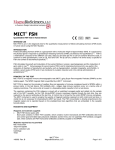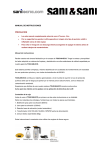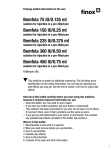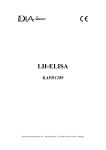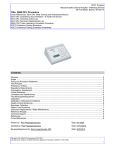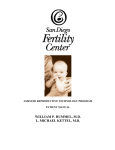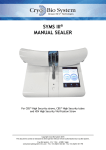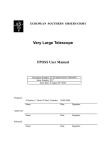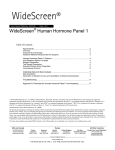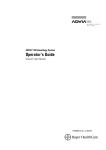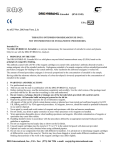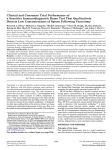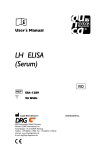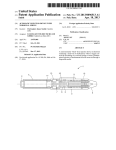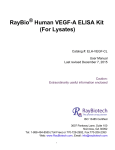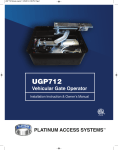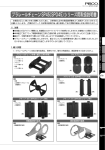Download LH - MagnaBioSciences
Transcript
MICT® LH Quantitative LH Test in Human Serum 850003 INTENDED USE ® MICT LH is an in vitro diagnostic test for the quantitative measurement luteinizing hormone (LH) in human serum using the MICT System. INTRODUCTION Gonadotropins (LH and FSH) maintain the normal function in male and female reproductive systems. In females, LH, in conjunction with FSH, is responsible for ovulation, stimulation of corpus luteum formation and ovarian progesterone synthesis. In males, LH stimulates production of testosterone by the Leydig cells and acts with FSH and testosterone to stimulate spermatogenesis. Luteinizing hormone (LH) or lutropin is a glycoprotein with a molecular weight of approximately 29,400 daltons. LH is composed of two non-covalently linked subunits designated alpha (α) and beta (β). The α-subunit of LH is common among several other hormones (follicle stimulating hormone, LH; thyroid stimulating hormone, TSH; and human chorionic gonadotropin, hCG), however, the β-subunit is unique, and confers biological as well as immunological specificity. Both the α- and β-subunits are required for biological activity. LH is secreted by the anterior pituitary in response to gonadotropin-releasing hormone (GnRH) secreted by the hypothalamus. Its synthesis is regulated with positive and negative feedback loops between the hypothalamus, pituitary gland, and the reproductive organs via pituitary and sex steroid hormones such as progesterone or estrogen. A failure at any regulatory level can result in either underproduction (infertility) or overproduction (hypogonadism) of LH. In females, hypogonadism can be a result of a decrease in steroid hormone levels due to immature ovaries, ovarian failure, polycystic ovary disease, or menopause. In males, hypogonadism results if the testes develop abnormally or anorchia exists. High levels of LH also exist in patients with primary testicular failure and Klinefelter syndrome. In both sexes, increased LH concentration can result from severe starvation, hyperthyroidism, cirrhosis or renal failure. A decrease in LH causes infertility in both sexes and occurs if LH is under produced by the anterior pituitary or if GnRH isn’t released from the hypothalamus. Therefore, with the advent of sensitive immunoassays, LH has become one of the recommended analytes for evaluation of suspected hypothalamic, pituitary, or gonadal dysfunction (in conjunction with LH and hCG, as well as pituitary or sex hormone assays). Furthermore, the hormone levels can be used to determine menopause, pinpoint ovulation and monitor endocrine therapy. PRINCIPLE OF THE TEST MICT LH is a magnetic immuno-chromatographic test (MICT) using Super Para-magnetic Particles (SPMPs) as the ® labeling agent. The SPMP magnetic field is quantified by a MICT Instrument. MICT LH is based on the principle of capillary flow and separation of immune complexes bound to SPMPs within a porous matrix. In the test device, LH antibody (Ab) - antigen (Ag) immune reactions occur on a narrow strip of capillary membrane. The narrow strip is housed in a disposable plastic cassette to form a test device. The specimen containing the LH antigen is mixed with a lyophilized conjugate pellet and added into the sample well of the MICT cassette. As the LH Ab-Ag-SPMP immune complexes migrate through the test strip, they are captured by the second antibody at the test line. A Control line is formed by the control SPMP immune complexes. The MICT instrument is used to analyze the quantity of magnetic particles captured on both control and test lines. A visible line is not necessary for interpreting the MICT test result. The LH concentration is directly proportional to the magnetic signal and is reported based on the predetermined test algorithms that are embedded in the cassette barcode labels. ® 148003 Rev. B MICT LH MagnaBioSciences, LLC Page 1 of 6 REAGENTS AND EQUIPMENT Reagents and materials supplied: ® • MICT LH Test Device (20) ® Each pack contains (1) MICT LH cassette, whichcontains murine monoclonal anti-LH antibodies (test line) and control goat-anti-rabbit IgG polyclonal antibodies (control line); and (1) lyophilized LH antibody conjugate tube, which contains anti-LH monoclonal antibodies (test SPMP) covalently coupled to the SPMPs,and a rabbit IgG coupled to the SPMP (control SPMP) Materials required but not provided MICT Instrument 100µl mini-pipette Pipette tips Serum collection tube Centrifuge Timer STORAGE Store at 1 – 30 °C PRECAUTIONS The test is designed for in vitro diagnostics and is for professional use only. Wear protective gloves and masks throughout the test procedure. Wash hands thoroughly after handling specimens. Do not pipette by mouth. Do not eat, drink or smoke in designated work areas. Follow standard guidelines for proper handling and disposal of patient specimens, chemical reagents, used test devices and all other materials used during the test. MICT tests are stable within the expiration date when stored and handled as directed. Do not use MICT tests beyond the expiration date. Do not use a test device from a compromised pouch. Specimens with repeated freeze-thaw cycles can cause abnormal results. SPECIMEN COLLECTION AND STORAGE For handling, processing and storing blood samples, read the following notes, as well as the manufacturer’s procedures on sample collection tubes. Follow routine procedures and precautions for venipuncture. Draw blood into serum collection tubes. Keep the tubes sealed at all times. For serum samples, allow blood to clot completely before centrifugation. Samples should be centrifuged and refrigerated within 2 hours of blood draw. Serum should be physically separated from cells as soon as possible, with a maximum time limit of 2 hours from centrifugation. Remove any residual fibrin or cellular matter. Turbid serum samples containing particular matter should be transferred from the original tube and re-centrifuged prior to assay. Samples should be tested within 8 hours of blood draw. ASSAY PROCEDURE Open the foil pouch; take out the conjugate tube and the test cassette. Place the cassette on a dry, flat surface. The test device should be used immediately after opening the pouch. Mark patient ID on the cassette as necessary. Hold the conjugate tube or place it in a rack. Make sure that the small conjugate pellet is at the bottom of the tube by gently tapping the wall of the tube. Use a standard 100 µL pipette and add 100 µL of patient serum sample into the conjugate tube. Mix the serum with the lyophilized conjugate pellet by pipetting up and down 3 - 4 times. Use the same pipette tip from the previous step, transfer all contents of the mixed solution into the sample well on the test cassette. Set a timer and wait for 30 minutes. After 30 minutes, insert the test cassette into the MICT Instrument and close the door. The instrument will immediately initiate the barcode reading and perform test verification. In approximately 10 - 15 seconds, the verification will be complete as indicated by the illuminated green “READY” light. Verify test name and sample source displayed on the instrument screen, input patient ID and/or patient number, ® 148003 Rev. B MICT LH MagnaBioSciences, LLC Page 2 of 6 and then press the “START” button. This initiates the MICT analysis of the test and control lines. The LH serum concentration in mIU/ml is displayed and printed. For detailed instructions on how to use the MICT Instrument, refer to the MICT Instrument User Manual. RESULTS The MICT instrument automatically determines LH concentration in the sample using the information on the test device barcode label. CALIBRATION A calibration master curve is generated for each lot of MICT LH, using master calibrators referenced to the WHO 2nd international standard for LH (IS 80/552). The master curve information is transferred to the MICT instrument through the barcode label on the test cassette. The MICT LH assay requires no calibration at the customer site. QUALITY CONTROL A. MICT Instrument Verification The performance of the MICT Instrument can be tested on a regular basis using the verification cassette (supplied with the MICT Instrument). The verification cassette contains three test regions on the strip that are pre-measured and are stable magnetic signals. These signals are used to verify the instrument internal calibration and system performance. After inserting the verification cassette, the MICT Instrument will perform a series of measurements and compare the results to the calibrated values stored in the cassettes barcode. Verification results should pass on all test items including the Overall Test, Accuracy and Noise. B. Built-in Procedural Control A built-in control line is present to assure that 1) reagents and test devices are functional; 2) test procedures are carried out correctly; and 3) test results are valid. If the control line value does not meet the specific QC standard, an error message will appear, indicating that the test is invalid. If this occurs, the test must be repeated. C. LH Controls Good laboratory practice includes the use of control materials to ensure that tests are performed properly. Follow the federal, state, and local requirements for each individual laboratory. If LH controls are out of range, re-run the test; if the problem continues, contact MagnaBioSciences or your local distributor, for technical support. LIMITATION OF PROCEDURE The performance of the MICT LH has been established using serum samples only. Specimens can be measured within the reportable range. For accurate results, serum LH levels greater than 100 mIU/mL should be tested with another method. Specimens from patients who have been exposed to mouse monoclonal antibodies may interfere with the test results, and show falsely elevated or depressed LH values. For diagnostic purposes, the MICT LH results should always be assessed in conjunction with other diagnostic findings and information obtained by the physician. If the LH level is inconsistent with clinical evidence, additional LH testing is suggested to confirm the result. MICT LH immunoassay does not show a high-dose hook effect up to 2,000 mIU/mL. EXPECTED RANGE 5 Expected values in serum for LH are summarized in the table below : LH mIU/mL 1.2 – 7.8 Males 23 -70 yrs Females Follicular Phase Midcycle Peak Luteal Phase Postmenopausal 1.7 -15.0 21.9 – 56.6 0.6 – 16.3 14.2 – 52.3 Each laboratory should determine its own reference ranges for its own patient population. ® 148003 Rev. B MICT LH MagnaBioSciences, LLC Page 3 of 6 PERFORMANCE CHARACTERISTICS Precision The reproducibility of MICT LH was measured by duplicate testing of pooled serum samples (n = 60) over a ten-day period using two MICT Instruments and three lots of MICT LH test devices. The test precision data are summarized below. MICT LH Precision (CV%) Sample Mean [LH] (mIU/mL) 0.82 5.9 48.3 1 2 3 Between Run CV% 8.3 8.4 7.5 Between Analyzer CV% 2.2 2.0 2.6 Between Reagent Lot CV% 4.1 4.5 3.8 TOTAL CV% 9.6 9.5 8.8 Method Comparison One hundred and nineteen (119) clinical samples were used to compare the serum values measured by the MICT LH and the Siemens ADVIA Centaur LH immunoassay. The agreement of the two methods was evaluated using Demings regression analysis. Pearson correlation r-value was used to test association between the values. n 119 Range of Observations (mIU/mL) 0.1 – 71.0 Intercept (mIU/mL) 0.26 Slope 1.02 r 0.96 Linearity Linearity was determined in accordance with CLSI protocol EP6-A. High and low value patient serum samples were used to prepare a set of linearity samples. The two samples were mixed in different ratios and the LH values determined using the MICT system and the results compared with expected values. The graph below summarizes the data. Interfering Substances Interfering substances were added to serum samples containing known amounts of LH. The value obtained for the serum with each interfering substance was compared to the value obtained for the serum without the interfering substance. These additives did not show interference at the levels indicated. Additives Bilirubin Hemoglobin Triglycerides Concentration 20 mg/dL 300 mg/dL 1,000 mg/dL ® 148003 Rev. B MICT LH MagnaBioSciences, LLC Page 4 of 6 Sensitivity and Assay Range Two lots of the MICT LH test were evaluated for sensitivity using the CLSI EP17-A protocol. The LOB, LOD, and LOQ are summarized as the average obtained from the two lots. Sensitivity Parameter Limit of Blank (LOB) Limit of Detection (LOD) Limit of Quantitation (LOQ) mIU/mL 0.01 0.06 0.09 The assay range is 0.09 mIU/mL to 100 mIU/mL Specificity The MICT LH assay was tested for potential cross-reactivity against the closely related hormones: TSH, hCG, and FSH. The results are summarized below. Hormone TSH hCG FSH Concentration 2 mIU/mL 200K mIU/mL 3000 mIU/mL Cross-Reactivity (%) nd <0.5 nd ® 148003 Rev. B MICT LH MagnaBioSciences, LLC Page 5 of 6 REFERENCES 1. Rose MP, Rose E. Das G. and Balen AH. Definition and Measurement of Follicle Stimulating Hormone. Endocrine Reviews 2000;21(1): 5-22 2. Dahl KD and Stone MP. LH Isoforms, Radioimmunoassays, Bioassays, and their Significance. J of Andrology. 1992;13:11-22. 3. Scott MG, Ladenson JH, Green ED, et al. Hormonal Evaluation of Female Infertility and Reproductive Disorders. Clin Chem. 1989;35:620-29. 4. Hayes FJ, Sluss PM. Reproductive Endocrinology. In: Lewandrowski K, editor. Clinical Chemistry: Laboratory Management and Clinical Correlates. New York Lippincott Williams and Williams; 2002. p.625-38. 5. Demiers, LM. Pituitary Function. In:Burtis, CA and Ashwood, ER, editors. Tietz Textbook of Clinical Chemistry, W.B. Saunders Company, 1999, p.1485. TECHNICAL SUPPORT For direct technical assistance, contact your local distributor or MagnaBioSciences. 6325 Lusk Blvd. San Diego, CA 92121 USA TEL: +1 (858) 481-4400 FAX: +1 (858) 481-7410 Email: [email protected] ® The MICT measurement technology and assays are covered by US Patents 6,046,585; 6,275,031; 6,437,563; 6,483,303; 6,518,747; 6,597,176; 6,607,922; 6,927,570 and foreign equivalents. Other patents are pending. ® 148003 Rev. B MICT LH MagnaBioSciences, LLC Page 6 of 6






